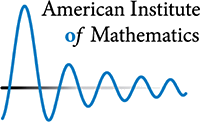
Modeling the Nation’s Food System
With over seven billion people living on our planet, how do we ensure a secure food system? How do we manage to produce, harvest, process, transport, sell, and eventually prepare the food we consume and do this better so that over one billion people are not hungry? Food system activities, like those described above comprise a highly complex system, with complicated feedback loops. To address...

Topology of Shapes, Persistent Homology and Point Clouds: Where Does it Take Us?
When viewed from the outside, a human brain appears as a volume with a highly wrinkled surface having numerous long crevices. Sulcal fundi are 3D curves that lie in the depths of the cerebral cortex; informally, the fundus of a sulcus is the curve of maximal average depth that spans the length of the sulcus. The sulcal fundi serve as anatomical landmarks, `segmenting’ the cortex into...

Non-equilibrium Dynamics and Random Matrices
During the academic year 2013-2014, the School of Mathematics conducted a special program on Non-equilibrium Dynamics and Random Matrices. This program was led by Distinguished Visiting Professor Horng-Tzer Yau from Harvard University, and Thomas Spencer (IAS). Yau is a leading expert on both random matrix theory and non-equilibrium dynamics. He was joined by senior participants L. Erdös, J....

The Secret Life of Red Blood Cells Revealed Through Topological Data Analysis
Red blood cells serve the critical biological function of delivering oxygen to all parts of the human body. Yet the cell’s ability to perform its job undergoes many changes as it ages. It will typically shrink in volume by 30 percent, while the membrane becomes increasingly stiff. The loss in elasticity of the membrane results in an impairment of their ability to pass through microscopic...

The Kakeya Problem
Author: Larry Guth (MIT) The Kakeya problem is an open problem in Euclidean geometry, and it was a central theme in the 2014 IPAM long program “Algebraic Techniques for Combinatorial and Computational Geometry”. It is elementary to state, but it’s also a model for deep open questions in Fourier analysis. Different approaches to the problem have involved tools and ideas from many subfields of...

Kadison-Singer Resolved
In 2013, the Kadison-Singer problem was solved by Adam Marcus, Dan Spielman, and Nikhil Strivastava. As Dana Mackenzie said in the January/February 2014 issue of SIAM News, the Kadison-Singer problem was like a “great subterranean river of mathematics, mysteriously disappearing below the surface and reappearing where you least expect it.” The problem appeared in different guises in mathematical...

Topology Provides Tools for Intrusion Detection with Robot Swarms
Robotic swarms are increasingly being designed for tasks deemed too difficult, time-consuming, or hazardous for humans, such as underwater exploration, wildlife sampling, surveillance, and search and rescue. These cheap, simple robots move using collective behaviors that emerge from local interactions with each other and their environment, functioning much like social insects. One use of robot...

Polygon Iterations
In the Fall of 2013, ICERM had a semester program on experiental geometry, topology, and dynamics. One of the many projects undertaken during this semester was the study of polygon iterations – geometrically defined maps on the space of polygons. Perhaps the simplest polygon iteration is the midpoint map. Starting with an n-gon P1, we let P2 be the n-gon whose vertices lie at the centers of the...

Modeling the Prevention and Reversal of Type 2 Diabetes
A highlight of the August 2013 Workshop for Young Researchers in Mathematical Biology held at MBI was a presentation by Dr. Arthur Sherman of the National Institutes of Health, describing work with NIH post-doctoral fellow, Joon Ha, on modeling the disease process in type 2 diabetes (T2D). Diabetes is an unfortunate byproduct of the phenomenal success of the human race in providing inexpensive...

Mathematics and Cosmology
The subject of cosmology has progressed dramatically in the last 10-20 years. This is illustrated by, among other things, the Nobel prizes in 2006 (cosmic microwave background) and in 2011 (observations of supernovae). In particular, the observations of supernovae led to the unexpected conclusion that the uni- verse is expanding at an accelerated rate. As a result, the currently preferred...